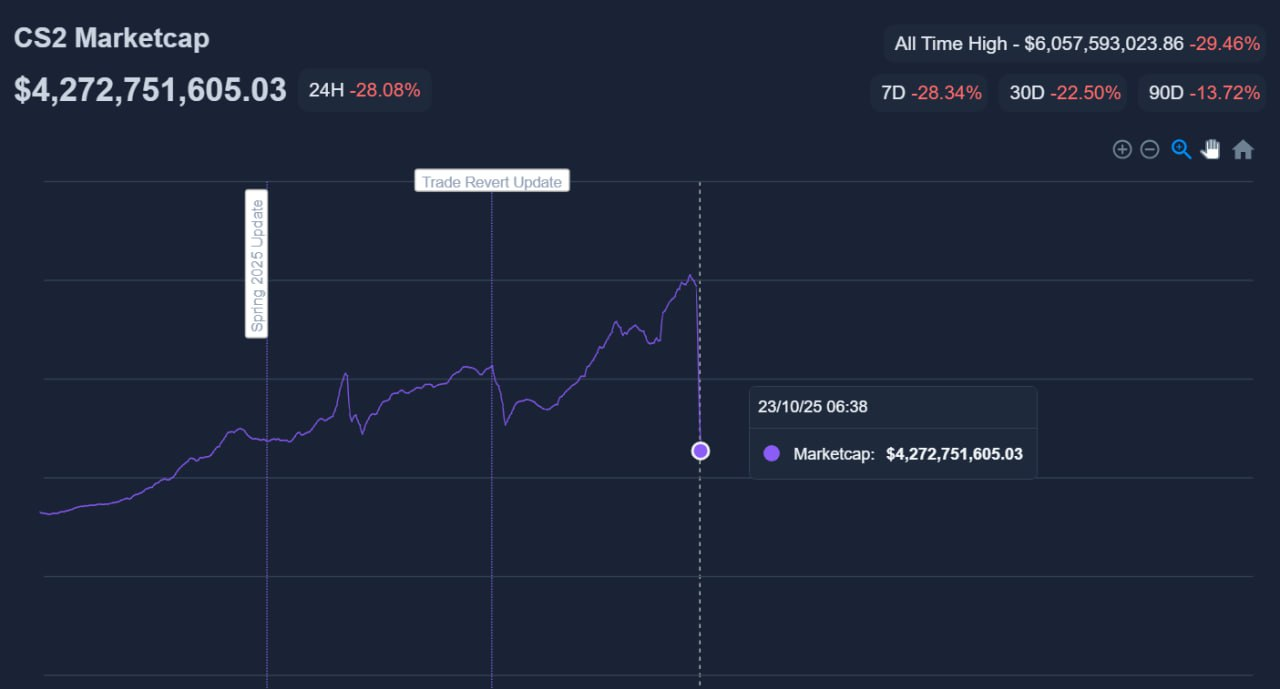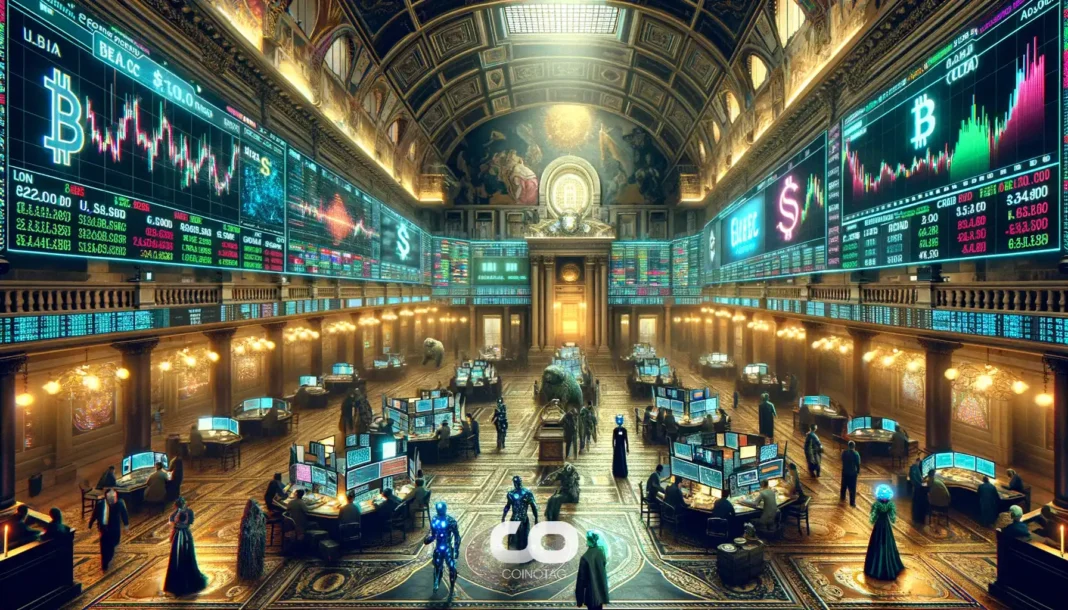The CS2 skins market crash, triggered by a Valve update allowing trades of high-tier items for knives and gloves, wiped out $1.784 billion in value overnight, dropping market cap from $6 billion to $4.27 billion—a 28% plunge mirroring crypto volatility driven by sudden supply shocks.
-
Valve’s patch enables exchanging five Covert skins for rare knives, flooding the market with supply.
-
Trading volumes stay stable as value shifts to other skins, preventing total liquidity loss.
-
Over 20 million Covert skins exist, potentially doubling knives from 5.5 million to 11 million, per CS Float data.
Discover how the CS2 skins market crash echoes crypto meltdowns: Valve’s update caused a $1.8B drop. Explore parallels, causes, and lessons for traders. Stay informed on volatile markets today!
What Caused the CS2 Skins Market Crash?
The CS2 skins market crash was precipitated by an abrupt Valve update that revolutionized the in-game economy, enabling players to trade five Covert-tier skins for high-value knives or gloves from the same collection. This change, implemented without prior warning, instantly increased the supply of premium items, leading to a sharp devaluation across the board. In a single day, the overall market capitalization plummeted by more than 28%, erasing nearly $1.8 billion in value and drawing stark comparisons to sudden crypto market corrections.

Source: Pricempire
The mechanics of this update are straightforward yet profoundly disruptive. Players can now convert relatively affordable Covert (red-tier) skins—often valued at around $100 each—into coveted knives or gloves that previously commanded prices up to $100,000 or more. Data from CS Float indicates that approximately 20 million Covert skins circulate in the market. If even a fraction of these are utilized in the new crafting system, the supply of knives and gloves could effectively double, surging from the current 5.5 million units to over 11 million. This influx has already manifested in dramatic price reductions: knives trading at $1,300 just days prior are now available for as low as $200, while ultra-premium variants exceeding $100,000 have seen proportional collapses.
Valve, as the central authority behind Counter-Strike 2 and the Steam platform, holds unparalleled control over this digital asset ecosystem. Unlike the decentralized nature of cryptocurrencies, where market forces and community consensus drive valuations, Valve’s decisions can unilaterally alter supply dynamics. This patch appears to be a strategic pivot, possibly aimed at transitioning from controversial loot box mechanics— which have drawn regulatory attention worldwide—to a more direct and transparent acquisition model within the in-game shop. Experts in gaming economics, such as those cited in reports from Steam community analyses, suggest this move enhances player engagement by democratizing access to rare items, though at the cost of short-term market stability.
How Does the CS2 Skins Crash Compare to Crypto Market Volatility?
The parallels between the CS2 skins market crash and cryptocurrency downturns are uncanny, rooted in shared traits of speculation, hype-driven valuations, and vulnerability to supply-side shocks. Both markets thrive on scarcity and perceived rarity: just as Bitcoin’s price can surge on halving events or ETF approvals, CS2 skins have historically escalated due to limited drops and collector demand. However, when external interventions occur—like a protocol upgrade in crypto or Valve’s patch here—oversupply can trigger cascading sell-offs.
Consider the data: the CS2 market’s 28% drop in 24 hours rivals some of crypto’s infamous flash crashes, such as the 2022 Luna collapse that erased $40 billion in days. According to blockchain analytics firm Chainalysis, crypto markets often experience 20-30% intraday swings due to liquidity crunches or whale movements, much like how the sudden availability of knives diluted CS2’s premium segment. An expert quote from gaming economist Dr. Elena Vasquez, featured in a recent GDC panel discussion, underscores this: “Virtual economies like CS2 skins operate on the same psychological levers as crypto—FOMO and scarcity—making them equally prone to boom-bust cycles when central actors intervene.”
Yet, key differences persist. Crypto’s decentralization means no single entity like Valve can dictate terms; instead, events like the 2024 Bitcoin halving or Ethereum’s Dencun upgrade influence supply through code changes agreed upon by developers and miners. In contrast, the CS2 ecosystem’s centralized control allows Valve to absorb shocks without existential risk—trading volumes in skins have held steady post-crash, with capital merely reallocating to lower-tier items rather than evaporating entirely. This resilience highlights a lesson for crypto traders: while both markets mutate under pressure, centralized systems can enforce stability faster, albeit at the expense of trader autonomy.
Regulatory scrutiny adds another layer of comparison. Loot boxes in games have faced bans or restrictions in regions like Belgium and the Netherlands, prompting Valve’s shift toward craftable rewards. Similarly, crypto faces ongoing battles with bodies like the SEC over security classifications, where sudden policy shifts can mimic a “patch” by eroding investor confidence. Statistics from Newzoo’s 2024 Global Games Market Report show the in-game items sector at $50 billion annually, overlapping with crypto’s $2 trillion market cap, both fueled by digital natives seeking high-risk, high-reward assets.
From a trader’s perspective, the CS2 event serves as a microcosm of crypto risks. Tools like on-chain analysis in crypto parallel market trackers like Pricempire for skins, helping predict volatility. As one veteran skin trader noted in a Steam forum thread archived by community moderators, “It’s like watching a mini altcoin rug pull—value doesn’t disappear; it just finds new homes.” This mutation, rather than outright death, is a common thread: post-crash, CS2 liquidity persists, much like how crypto rebounds through diversification into stablecoins or DeFi yields.
Frequently Asked Questions
What Triggered the Rapid Decline in CS2 Skins Prices After the Valve Update?
The Valve update permitted exchanging five Covert skins for knives or gloves, instantly boosting supply of high-value items and causing prices to plummet. With 20 million Covert skins available, this could double rare item counts, leading to a 28% market cap drop from $6 billion to $4.27 billion in 24 hours, as reported by market trackers.
Why Is the CS2 Skins Market Crash Being Compared to Crypto Volatility?
The CS2 skins market crash shares crypto’s speculative nature, where hype and scarcity drive prices until supply shocks intervene. Unlike Bitcoin’s decentralized corrections, Valve’s centralized patch mirrors regulatory pivots in crypto, shifting values without killing liquidity—trading persists as funds move to other assets, offering a cautionary tale for digital economy enthusiasts.
Key Takeaways
- Supply Shocks Drive Volatility: Valve’s crafting update doubled potential knife supply, akin to crypto halvings in reverse, emphasizing the need for traders to monitor developer announcements.
- Centralization vs. Decentralization: While CS2’s market mutates under Valve’s control without total collapse, crypto’s lack of oversight can lead to wilder swings—diversify to mitigate risks.
- Lessons for Investors: Stable trading volumes post-crash signal resilience; apply this by tracking liquidity metrics in both gaming and crypto to spot recovery opportunities early.
Conclusion
The CS2 skins market crash exemplifies how sudden interventions can unravel digital economies, much like protocol upgrades or regulatory news in the crypto space. By flooding the market with rare items, Valve’s update not only erased $1.784 billion in value but also highlighted enduring parallels in speculation and recovery dynamics. As both sectors evolve amid scrutiny, traders should prioritize liquidity assessments and diversification strategies to navigate future volatility. Looking ahead, this event could inspire more transparent models in gaming and blockchain, fostering sustainable growth for virtual asset markets worldwide.





